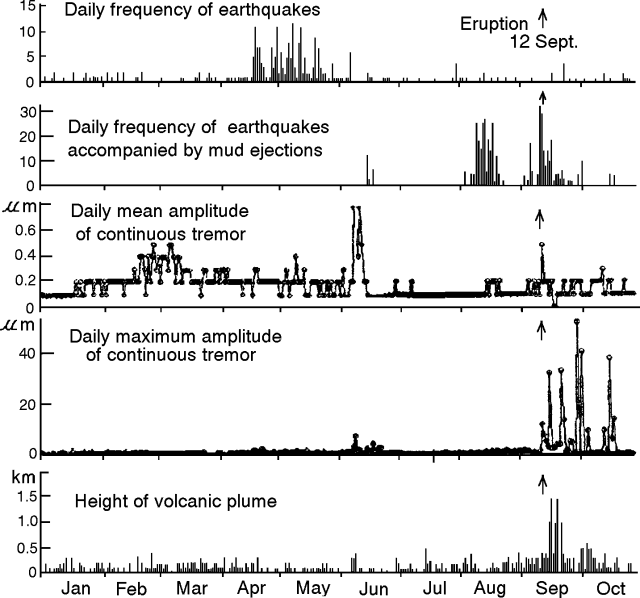Report on Asosan (Japan) — October 1994
Bulletin of the Global Volcanism Network, vol. 19, no. 10 (October 1994)
Managing Editor: Richard Wunderman.
Asosan (Japan) Continued mud ejections and ash plumes from Nakadake crater 1
Please cite this report as:
Global Volcanism Program, 1994. Report on Asosan (Japan) (Wunderman, R., ed.). Bulletin of the Global Volcanism Network, 19:10. Smithsonian Institution. https://doi.org/10.5479/si.GVP.BGVN199410-282110
Asosan
Japan
32.8849°N, 131.085°E; summit elev. 1592 m
All times are local (unless otherwise noted)
After ejecting mud and blocks on 12 September, Crater 1 remained restless in October (figure 26). The water-covered crater floor ejected mud intermittently, sometimes accompanied by ash plumes. In one case on 27 October, ejected mud flew more than 100 m above the crater bottom. Tremor amplitude (at Station A, 800 m W of the crater) generally remained less than 1 µm. Some larger tremor episodes exceeded 10 µm and were felt by personnel at the Aso Weather Station.
Geological Summary. The 24-km-wide Asosan caldera was formed during four major explosive eruptions from 300,000 to 90,000 years ago. These produced voluminous pyroclastic flows that covered much of Kyushu. The last of these, the Aso-4 eruption, produced more than 600 km3 of airfall tephra and pyroclastic-flow deposits. A group of 17 central cones was constructed in the middle of the caldera, one of which, Nakadake, is one of Japan's most active volcanoes. It was the location of Japan's first documented historical eruption in 553 CE. The Nakadake complex has remained active throughout the Holocene. Several other cones have been active during the Holocene, including the Kometsuka scoria cone as recently as about 210 CE. Historical eruptions have largely consisted of basaltic to basaltic andesite ash emission with periodic strombolian and phreatomagmatic activity. The summit crater of Nakadake is accessible by toll road and cable car, and is one of Kyushu's most popular tourist destinations.
Information Contacts: JMA.


